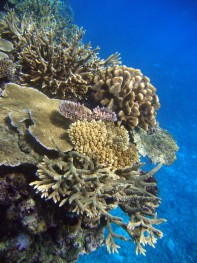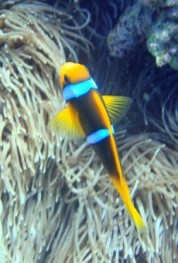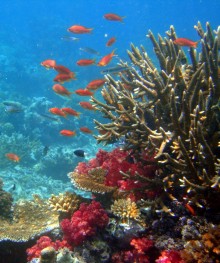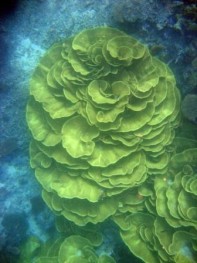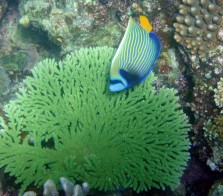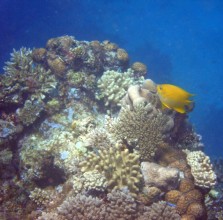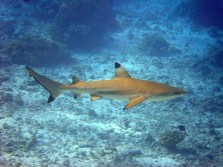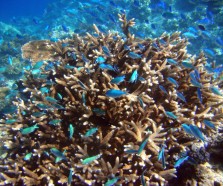



Journal 34; Northern Fiji
June 2 - June 23, 2011
After ten days in the village of Savusavu, Fiji it was time to see some Fijian ‘wildlife’. We picked a day of no wind to motor east into the normal prevailing east trade winds. We prefer to sail vs. motor but on this trip we caught two black fin tuna, one yellow fin tuna and a mahi. We were happy!
Our destination was Budd’s Reef, a large reef with a few breaks that we could carefully guide El Regalo through. In the middle of Budd’s Reef there are several small islands including one that is inhabited. After setting the anchor we went into the tiny village to follow Fijian protocol by introducing ourselves to the village chief and presenting him the traditional gift (sevusevu) of kava (a South Pacific root that is ground to make a grog). The chief, Jack, was a well educated individual and he was a super cool guy. Jack invited us to their Sunday dinner which was fresh lobster marinated in fresh coconut milk, fresh fish cooked with taro leaves and taro root; all served on a woven mat under a tree on the beach. We took Jack’s photo with his ‘boys’, the majority of which were his grandsons, and they proudly displayed homemade birds they had made from coconut shells.
Like most homes throughout the South Pacific, Fijian houses are small 1 or 2 room houses with little or no furniture. They sit on the floor during the day and sleep on mats at night.
Our destination was Budd’s Reef, a large reef with a few breaks that we could carefully guide El Regalo through. In the middle of Budd’s Reef there are several small islands including one that is inhabited. After setting the anchor we went into the tiny village to follow Fijian protocol by introducing ourselves to the village chief and presenting him the traditional gift (sevusevu) of kava (a South Pacific root that is ground to make a grog). The chief, Jack, was a well educated individual and he was a super cool guy. Jack invited us to their Sunday dinner which was fresh lobster marinated in fresh coconut milk, fresh fish cooked with taro leaves and taro root; all served on a woven mat under a tree on the beach. We took Jack’s photo with his ‘boys’, the majority of which were his grandsons, and they proudly displayed homemade birds they had made from coconut shells.
Like most homes throughout the South Pacific, Fijian houses are small 1 or 2 room houses with little or no furniture. They sit on the floor during the day and sleep on mats at night.
Click on underwater photos to enlarge.
After several days of snorkeling and hiking the small mountain (without a trail) we moved to several other locations for snorkeling, relaxing and doing a few chores. Later we were joined for a few days by our friend Neli, of s/v Basjacko (Serbia). It was a nice change to a have a guest that is a cruiser and we shared many laughs while cooking, hiking and snorkeling.
Our best snorkeling was at Rainbow Reef with the local guide coincidently also named Jack. He was a real character and very knowledgeable since he has dived, captained and crewed throughout Fiji since the 60’s.
Our best snorkeling was at Rainbow Reef with the local guide coincidently also named Jack. He was a real character and very knowledgeable since he has dived, captained and crewed throughout Fiji since the 60’s.
While on the east side of Taveuni Island we met, Jim, an interesting man with an interesting story. Jim’s grandfather emigrated from Germany to Fiji in 1876. Jim’s grandfather was a sailing captain that was lost at sea during a hurricane in the 1920’s. Jim speaks Fijian and has a small ranch with cattle, pigs, sheep and goats. He and his son also make copra which is dried coconut shells that are used to make fragrances. Copra is very labor intensive and they get paid US$480/ton for the dried copra (and they are very happy with this price). You don’t get an experience like this while on a tour bus!
The next day we had an all day hike to the waterfalls at the Bouma National Heritage Park. As we went ashore we met Claude an expatriate operating a pearl farm in the bay. His dog adopted us, spending the entire day leading us to the two falls and back. Walking the gravel road (most roads in Fiji are not paved) was an interesting experience. Every person we passed along the way would stop and chat with us. They would introduce themselves, tell us where they were going, and why, and then they would ask where we were going. It was nice to meet such genuinely friendly people. We were out of fresh veggies and decided that cassava was probably something we could find on the island so we started asking the farmers we met if we could buy some. After a few misses we got a hit. He gave us some bananas to eat and told us to stop on the way back for the cassava. Now this is fresh produce!
Cassava is also known as yucca. Cassava is the world’s third largest source of carbohydrates (rice & potatoes are #1 & #2?) and Nigeria is the biggest producer. Cassava is very dense and is delicious in soups, stews or as a side dish. That night we used our cassava in a curried beef dish and it was quite good.
We spent our final day motor sailing along the uninhabited eastern coastline of Taveuni. The terrain is quite rugged and there are no roads. The view was spectacular with dense rainforests and abundant dramatic cascades.
There was little wind for our sail back to Savusavu but we did catch more tuna (3 double hook-ups) so it was a great day to end our venture throughout the Northeastern Fiji Islands.
We spent our final day motor sailing along the uninhabited eastern coastline of Taveuni. The terrain is quite rugged and there are no roads. The view was spectacular with dense rainforests and abundant dramatic cascades.
There was little wind for our sail back to Savusavu but we did catch more tuna (3 double hook-ups) so it was a great day to end our venture throughout the Northeastern Fiji Islands.
In summary, we spent 14 days in the NE Fiji Islands, we caught 13 fish, motored more than we like but we did sail sime, we got to know the Fijian people and their culture and we had some spectacular snorkeling. We depart Savusavu today headed toward SW Fiji and then on to the Western Fijian Islands.
Best regards,
Brian and JoDon
Best regards,
Brian and JoDon
